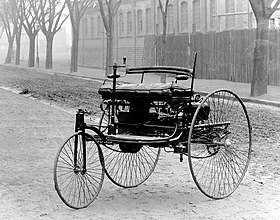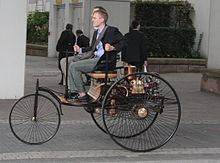The Benz Patent-Motorwagen ("patent motorcar"), built in 1885 by the German Karl Benz, is widely regarded as the first practical modern automobile[1][a] and was the first car put into production.[8] It was patented and unveiled in 1886. The original cost of the vehicle in 1886 was 600 imperial German marks,[9] approximately 150 US dollars (equivalent to $5,100 in 2023).
| Benz Patent-Motorwagen | |
|---|---|
 Benz Patent-Motorwagen Nr. 1 | |
| Overview | |
| Manufacturer | Rheinische Gasmotorenfabrik Benz & Cie. (known today as Mercedes-Benz) |
| Production | 1886–1893 |
| Powertrain | |
| Engine | 1.0L (954cc) single cylinder engine 2⁄3hp (Ligroin fuel) |
| Chronology | |
| Successor | Benz Velo |
Two years after Karl Benz first drove the car in July 1886,[10] Karl's wife Bertha demonstrated its feasibility in a trip from Mannheim to Pforzheim in August 1888, shortly before it became the first commercially available automobile in history in the late summer of 1888.[11]
Due to the creation of the Patent-Motorwagen, Karl Benz has been hailed as the father and inventor of the automobile.[1][12][13]
Development, specifications and Karl Benz's first drive


After developing a successful gasoline-powered two-stroke piston engine in 1873, Benz focused on developing a motorized vehicle while maintaining a career as a designer and manufacturer of stationary engines and their associated parts.
The Benz Patent-Motorwagen was a motor tricycle with a rear-mounted engine. The vehicle contained many new inventions. It was constructed of steel tubing with woodwork panels. The steel-spoked wheels and solid rubber tires were Benz's own design. Steering was by way of a toothed rack that pivoted the unsprung front wheel. Fully elliptic springs were used at the back along with a beam axle and chain drive on both sides. A simple belt system served as a single-speed transmission, varying torque between an open disc and drive disc.
The first Motorwagen used the Benz 954 cc (58.2 cu in) single-cylinder four-stroke engine with trembler coil ignition.[14] This new engine produced 500 watts (2⁄3 hp) at 250 rpm in the Patent-Motorwagen, although later tests by the University of Mannheim showed it to be capable of 670 W (0.9 hp) at 400 rpm. It was an extremely light engine for the time, weighing about 100 kg (220 lb). Although its open crankcase and drip oiling system would be alien to a modern mechanic, its use of a pushrod-operated poppet valve for exhaust would be quite familiar. A large horizontal flywheel stabilized the single-cylinder engine's power output. An evaporative carburettor was controlled by a sleeve valve to regulate power and engine speed. The first model of the Motorwagen had not been built with a carburettor, rather a basin of fuel soaked fibers that supplied fuel to the cylinder by evaporation.[citation needed]
The vehicle was awarded the German patent number 37435, for which Karl Benz applied on 29 January 1886. Following official procedures, the date of the application became the patent date for the invention once the patent was granted, which occurred in November of that year. Benz unveiled his invention to the public on 3 July 1886, on the Ringstrasse in Mannheim. For the first time Karl Benz publicly drove the car on July 3, 1886, in Mannheim at a top speed of 16 km/h (10 mph).[10]
Benz later made more models of the Motorwagen: model number 2 had 1.1 kW (1.5 hp) engine, and model number 3 had 1.5 kW (2 hp) engine, allowing the vehicle to reach a maximum speed of approximately 16 km/h (10 mph). The chassis was improved in 1887 with the introduction of wooden-spoke wheels, a fuel tank, and a manual leather shoe brake on the rear wheels.[citation needed]
About 25 Patent-Motorwagen were built between 1886 and 1893.[citation needed]
Bertha Benz's trip
Bertha Benz, Karl's wife, whose dowry was said to have made a portion of contribution to finance the development of the Patent-Motorwagen,[15] was aware of the need for publicity. She took the Patent-Motorwagen No. 3 and drove it on the first long-distance internal combustion automobile road trip to demonstrate its feasibility. That trip occurred in early August 1888, when she took her sons Eugen and Richard, fifteen and fourteen years old, respectively, on a ride from Mannheim through Heidelberg, and Wiesloch, to her maternal hometown of Pforzheim.[16]

In Germany, a parade of antique automobiles celebrates this historic trip of Bertha Benz every two years. On February 25, 2008, the Bertha Benz Memorial Route,[17] following the route of Benz's journey, was officially approved as a Tourist or Scenic Route by the German authorities as a route of industrial heritage of mankind. The 194 km (121 mi) of signposted route leads from Mannheim via Heidelberg to Pforzheim (Black Forest) and back.
In media

The car can be driven in the video game Gran Turismo 4 and Android video game Driving Legends: The Car Story. It was also driven by Sherlock Holmes's sister Enola in the film Enola Holmes.
See also
- History of the automobile
- Benz Velo (later 4 wheel model)
- List of Mercedes-Benz vehicles (incl. summary of Benz vehicles)
- List of motorcycles of the 1890s
- List of motorized trikes
- Three-wheeler
Notes
References
External links

- Patent 37435, by Karl Benz for his 1885 Motorwagon The birth certificate of the automobile – the German patent application of January 29, 1886, that was granted on November 2, 1886, to Benz & Company in Mannheim
- Automuseum Dr. Carl Benz, Ladenburg (Heidelberg)
- John H. Lienhard on Bertha Benz's ride